Neisseria cinerea
Introduction
N. cinerea was first described as Micrococcus cinereus by von Lingelsheim in 1906. Isolates of N. cinerea (N. cinereus) were identified as M. catarrhalis (Neisseria catarrhalis); sometimes N. cinerea isolates were recognized as belonging to a colonial morphologic subtype of M. catarrhalis (Neisseria catarrhalis). In 1934, Huntoon described N. pseudocatarrhalis, whose description was consistent with that of N. cinerea. N. cinerea was not recognized and correctly identified again until 1962 in Germany and in 1984 in the United States. By DNA hybridization studies, N. cinerea exhibits approximately 50% relatedness to N. gonorrhoeae.
N. cinerea has been isolated from endocervical and rectal infections, from conjunctivitis in neonates, and from lymphadenitis, and has been misidentified repeatedly as N. gonorrhoeae. Strains of N. cinerea have been isolated from the conjunctiva of newborns treated prophylactically with erythromycin and misidentified as N. gonorrhoeae. Thus, a gram-negative, oxidase-positive diplococcus isolated on nonslective media should be identified by definitive methods. N. cinerea has been isolated on gonococcal selective media for the identification of N. gonorrhoeae. Some strains of N. cinerea may grow when subcultured on selective media. Colonies of N. cinerea are similar in size, appearance, and consistency with those of N. gonorrhoeae. Similar to N. gonorrhoeae, N. cinerea may also give rise to different colony forms that vary in diameter, degree of convexity, and opacity.
N. cinerea has been misidentified as N. gonorrhoeae not only because of similarities in colonial morphology but also because of similarities in biochemical activities. Although N. cinerea is considered to be glucose-negative, strains may produce weak acid reactions from glucose in some acid detection tests. N. cinerea produces acid from glucose but rapidly overoxidizes the acid to carbon dioxide with the result that acid does not accumulate in the reaction tube although the carbohydrate has been used. Thus, depending on the buffering capacity of the medium, N. cinerea strains may be identified as weakly glucose-positive or glucose-negative. N. cinerea may be misidentified as N. gonorrhoeae if tested only with an enzyme substrate test because both species produce are hydroxyprolylaminopeptidase-positive.
Some N. cinerea isolates may be misidentified as gonococcal strains because they have reacted in coagglutination serologic tests performed in accordance with the manufacturer's directions.
Table 1. Characteristics of N. cinerea
| Characteristic | Illustration |
|---|---|
| Gram stain Cell Morphology | Gram-negative diplococcus |
N. cinerea strains produce colonies that resemble those of N. gonorrhoeae in size and general appearance. N. cinerea colonies are slightly more pigmented after incubation for 48 h. Similar to N. gonorrhoeae, colonies of some N. cinerea strains autolyze after 24 h. incubation whereas colonies of other strains may remain butyrous for several days without any indication of autolysis. | 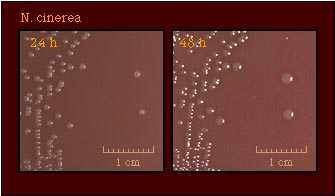 |
N. cinerea strains are slightly more pigmented than those of N. gonorrhoeae. A golden-brown pigmentation may be apparent after incubation for 24 h. compared with the pinkish-brown pigmentation of N. gonorrhoeae strains. The "brighter" pigmentation evident after 48 h. incubation reflects the fact that colonies of this strain had autolyzed. | 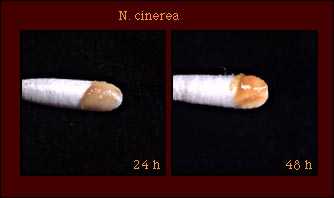 |
| Oxidase Test | 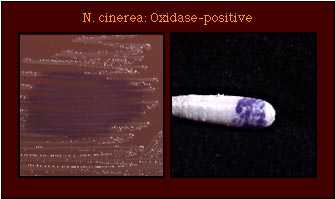 |
| Acid Production Strains of N. cinerea produce acid from glucose, but overoxidize this acid to carbon dioxide. Thus, acid is not usually detected from glucose. However, the carbonic acid produced when carbon dioxide is produced may result in a weak acid reaction from glucose in some acid detection tests. |  |
| Enzyme Substrate Test | Hydroxyprolylaminopeptidase-positive |
| Nitrate Reduction Test | Nitrate -ve |
| Polysaccharide from Sucrose | 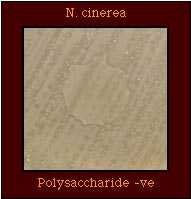 |
| Production of Deoxyribonuclease (DNase) |  DNase -ve |
| Superoxol Test (Reaction with 30% hydrogen peroxide) | 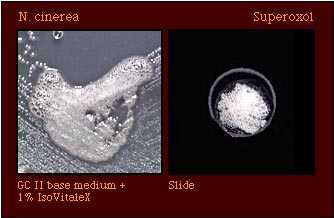 Weak (2+) reactions |
| Catalase Test (Reaction with 3% hydrogen peroxide) |  Catalase-positive |
| Colistin Resistance | 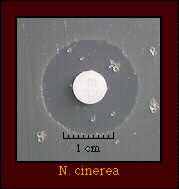 Most strains are colistin-susceptible; some strains are colistin-resistant and may be isolated on selective media for N. gonorrhoeae |
Species which may be misidentified as N. cinerea in acid detection tests
Based on acid production patterns, N. cinerea may be misidentified as M. catarrhalis, N. flavescens, or as a glucose-negative strain of N. gonorrhoeae. Supplemental tests that may aid in differentiating between species that produce no detectable acid from carbohydrates are shown in Table 2.
Table 2. Supplemental tests which permit differentiation among gram-negative diplococci that produce no detectable acid from carbohydrates.
| Species that produce no detectable acid | Gram Stain | Enzyme Substrate | DNase | Superoxol | Polysaccharide from sucrose | Nitrate reduction | Colistin susceptibility |
|---|---|---|---|---|---|---|---|
N. cinerea | GND | Hydroxy- prolylamino- peptidase +ve | - | Weak (2+) | - | - | (R) |
| (Glucose-negative N. gonorrhoeae) | GND | Hydroxy- prolylamino- peptidase +ve | - | Strong (4+) reaction | - | - | R |
M. catarrhalis | GND | No reaction | + | Strong (1+ to 4+) reaction | - | + | (R) |
N. flavescens | GND | Hydroxy- prolylamino- peptidase +ve | - | Weak (2+) reaction | + | - | S |
N. elongata | GNR | Hydroxy- prolylamino- peptidase +ve | - | - | - | - | S |
Abbreviations. GND, Gram-negative diplococcus; GNR, Gram-negative rod; +, most strains positive; -, most strains negative; R, strains grow well on selective medium for N. gonorrhoeae and/or show no inhibition around a colistin disk (10 micrograms); (R), most strains susceptible, some strains resistant.
Although enzyme substrate tests are intended to be used only for the identification of Neisseria spp. isolated on selective media for N. gonorrhoeae, these tests do provide additional information that may aid in accurately identifying an isolate. However, N. cinerea produces hydroxyaminopeptidase in enzyme substrate test and may be misidentified as N. gonorrhoeae if additional tests are not performed.
Table 3. Supplemental tests which permit differentiation among Neisseria and related species that produce hydroxyprolylaminopeptidase in enzyme substrate tests.
| Species that Produce Hydroxyprolylamino- peptidase | Cellular Elongation* | Acid from | Nitrate Reduction | Polysaccharide from Sucrose | Superoxol | Colistin Resistance | ||||
|---|---|---|---|---|---|---|---|---|---|---|
| G | M | S | F | L | ||||||
| N. cinerea | Diplococci | (-) | - | - | - | - | - | - | Weak (2+) positive | (R) |
| N. gonorrhoeae "N. kochii"* | Diplococci | + | - | - | - | - | - | - | Strong (4+) positive | R |
| K. denitrificans | Rod filaments | + | - | - | - | - | + | - | - | R |
| N. subflava biovar subflava | Diplococci | + | + | - | - | - | - | - | Weak (2+) positive | S |
| N. subflava biovar flava | Diplococci | + | + | - | + | - | - | - | Weak (2+) positive | S |
| N. subflava biovar perflava | Diplococci | + | + | + | + | - | - | + | Weak (2+) positive | (R) |
| N. sicca | Diplococci | + | + | + | + | - | - | + | Weak (2+) positive | S |
| N. mucosa | Diplococci | + | + | + | + | - | + | + | Weak (2+) positive | S |
| N. flavescens | Diplococci | - | - | - | - | - | - | + | Weak (2+) positive | S |
| N. elongata | Rod filaments | - | - | - | - | - | - | - | - | S |
- Page last reviewed: March 31, 2017
- Page last updated: October 17, 2008
- Content source:


 ShareCompartir
ShareCompartir